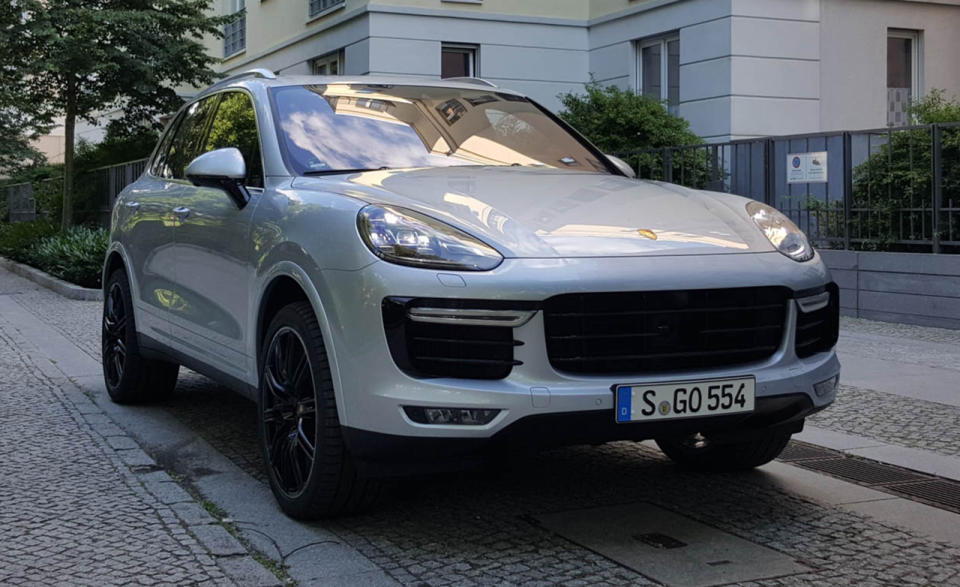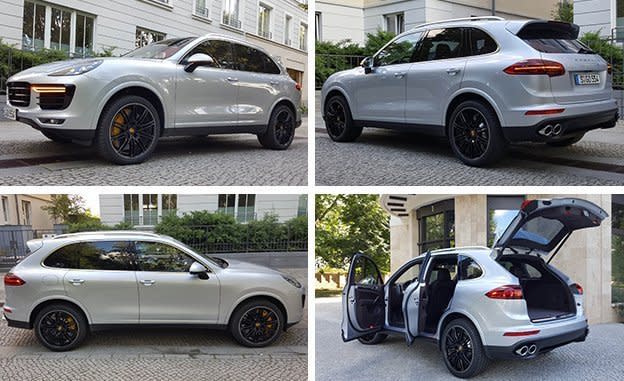2016 Porsche Cayenne Turbo S

The clock is ticking. In two years or so, we expect to be driving an entirely new Porsche Cayenne. Based on the Volkswagen Group's MLB II platform (which is also under the newest Audi Q7 and the Bentley Bentayga), it will be lighter, quicker, and more carlike than today’s model. But for now—and, given regulatory realities, perhaps forever—the 570-hp Cayenne Turbo S is the ultimate and most excessive variation of the original concept. There won't be another one that’s both as stout and as brutal, which is reason enough to take it out on its German home turf to see how it holds up in today's competitive surroundings.
The Cayenne, despite a thorough makeover for the 2011 model year, is still a close relative to the original, which was launched in 2002 on the Volkswagen PL71 platform shared with the VW Touareg. This is a big and heavy architecture, partly because Volkswagen and Porsche initially had visions of selling military versions of their SUVs to be built alongside the civilian models.

The Cayenne Turbo S tips the scales at a hefty 4927 pounds, according to its maker. To compound the obstacles to performance, its drag coefficient of 0.36 doesn't exactly rank at the slippery end of its class. It takes a lot of power to get something that big and blunt moving well enough to merit a Porsche badge. Add “Turbo S,” and expectations are lofty. Zuffenhausen’s engine-development specialists claim their 4.8-liter twin-turbocharged V-8 makes a full 570 horsepower and can hurl the Cayenne to 60 mph in a mere 3.8 seconds.
More Moreness
For 2016, engine output was increased by 20 horsepower from the previous 550. We first drove it in this configuration in February 2015, in far northern Sweden, where there was no real opportunity to explore the added power. The Cayenne Turbo S is especially convincing on its home turf in Germany. Where else would you notice the difference from the regular 520-hp Cayenne Turbo, let alone the 20 horsepower added since our last track test? But in the fight for position on the autobahn, at triple-digit velocities, when the passing lane is finally cleared and you need to close that gap in a rush, the extra power provided by this ridiculously fast SUV is most useful. It'll make everyone else yield the fast lane—including many real sports cars and the ubiquitous turbo-diesel executive sedans.
Porsche claimed a lap record on the Nürburgring Nordschleife with the Cayenne Turbo S, as the first SUV to complete the task in less than eight minutes. We’re not Walter Röhrl, the driver for that record, but from behind the wheel, the Turbo S feels as surreal as its numbers suggest. Step on the gas pedal, and the Cayenne charges forward with a menacing growl, exhibiting Tesla-like urgency but accompanied by a soundtrack that will put a big grin on your face. It seems as if there’s endless power at your command, moving the Turbo S to triple-digit speeds with minimal fuss and time investment. It actually tops out at an insane 176 mph. Of course, performance comes at a price: Good luck matching the official figures of 14 mpg in the city and 21 mpg on the highway. We’re sure a driver could feather-foot the Cayenne into doing that, but the power trip is simply too addictive to imagine achieving decent fuel economy as more than a party trick.
In Europe at least, the Cayenne is often used for towing, and that's one reason Porsche doesn't fit it with a dual-clutch automatic gearbox. This one comes with an eight-speed torque-converter automatic that is more robust and does its job well but is noticeably slower than the dual-clutch PDK box in Porsche’s Panamera sedan. In the sportiest driving mode, it doesn't upshift at redline, which is good, but it downshifts of its own volition at full throttle, which is not optimal.
From behind the wheel, the driver scans a retro-futuristic cockpit that pleases the eye but still requires some time to adapt to. There is a huge array of buttons, almost overwhelming in number even though they are logically arranged. The 2016 model went on sale last spring, and Porsche tells us that it’s pretty sure none are left on U.S. dealer lots. If you went in to order one, it’d be a ’17 model (priced $2300 higher at $160,650), which changes only in that it adapts the latest infotainment system, dubbed PCM 4.0, as seen in the new Panamera, using fewer buttons by moving many functions to a 12.3-inch center touchscreen. With early production devoted to the Platinum editions, no 2017 Turbo S models have been built yet, so there’s still time to place your deposit.
The rest of the cockpit features exquisite materials, but the rear passengers are exposed to evidence of cost cutting: Their reading lights are fitted with old-fashioned light bulbs instead of LEDs, and the armrest features open cupholders of a somewhat primitive design. We also hope that the next generation will offer a front-seat ventilation system with a fan that doesn't try to drown out every other sound in the vehicle.

A Plutocrat’s Road Tripper
The Cayenne Turbo S is ideal for long-distance travel. All passengers sit tall, with a great view of the surroundings, and the speed at which this vehicle can gobble up miles is stunning. The ride is never harsh, even with the chassis settings in the most aggressive Sport Plus mode, yet this SUV offers exemplary levels of roadholding. There is virtually no body roll, and the limits of adhesion are so far beyond legal speeds that you will have a tough time exploring them anywhere beyond the racetrack. If you do take it to a track (and why not?), notice that the Cayenne’s handling attitude remains neutral until cornering loads are enormous, when it begins to understeer gradually.
As a symbol of social inequality and brazen capitalism, the Cayenne Turbo S gets special scrutiny on German roads. The desire to pass is interpreted as a political statement, and harmless driving errors are regarded as a provocation: The rich always do whatever they want, right? In egalitarian Europe, the Cayenne Turbo S isn't met with general enthusiasm and admiration. Drivers of such vehicles there should wear sunglasses, assume an attitude of steely determination, and be ready to use the carbon-ceramic brakes. These formerly optional stoppers were made standard with the bump to 570 horses; the front calipers boast no fewer than 10 pistons to make sure this heavyweight can erase speed as readily as it builds it.
For better or for worse, the Porsche Cayenne has become a trendsetter. After being greeted by howls from enthusiasts all over the world when it was launched in 2002, it quickly won over new customers—and a lot of those who initially criticized the portly SUV now own one, if only to tow their Porsche sports cars to track events. Without the decidedly sporty Cayenne to set the bar high, we doubt there would be a BMW X6, a Range Rover Sport SVR, or a Maserati Levante. And after having spent this time in the brutally powerful Turbo S, we can submit that none has been able, so far, to outdo this modern-day monster.
Specifications >
VEHICLE TYPE: front-engine, 4-wheel-drive, 5-passenger, 4-door hatchback
Base Price: $158,350
ENGINE TYPE: twin-turbocharged and intercooled DOHC 32-valve V-8, aluminum block and heads, direct fuel injection
Displacement: 293 cu in, 4806 cc
Power: 570 hp @ 6000 rpm
Torque: 590 lb-ft @ 2500 rpm
TRANSMISSION: 8-speed automatic with manual shifting mode
DIMENSIONS:
Wheelbase: 114.0 in
Length: 191.1 in
Width: 78.7 in Height: 67.0 in
Cargo volume: 24 cu ft
Curb weight (C/D est): 4950 lb
Performance (C/D EST):
Zero to 60 mph: 3.8 sec
Zero to 100 mph: 9.4 sec
Standing ¼-mile: 12.3 sec
Top speed: 176 mph
FUEL ECONOMY:
EPA city/highway driving: 14/21 mpg

 Yahoo Autos
Yahoo Autos 